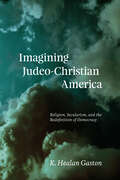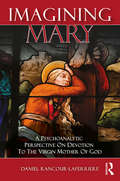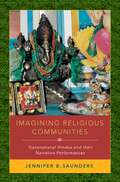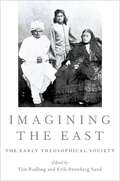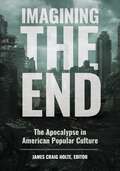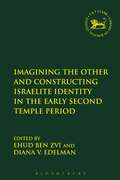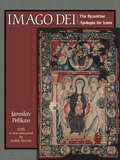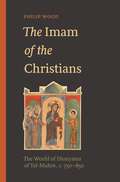- Table View
- List View
Imagining Judeo-Christian America: Religion, Secularism, and the Redefinition of Democracy
by K. Healan Gaston“Judeo-Christian” is a remarkably easy term to look right through. Judaism and Christianity obviously share tenets, texts, and beliefs that have strongly influenced American democracy. In this ambitious book, however, K. Healan Gaston challenges the myth of a monolithic Judeo-Christian America. She demonstrates that the idea is not only a recent and deliberate construct, but also a potentially dangerous one. From the time of its widespread adoption in the 1930s, the ostensible inclusiveness of Judeo-Christian terminology concealed efforts to promote particular conceptions of religion, secularism, and politics. Gaston also shows that this new language, originally rooted in arguments over the nature of democracy that intensified in the early Cold War years, later became a marker in the culture wars that continue today. She argues that the debate on what constituted Judeo-Christian—and American—identity has shaped the country’s religious and political culture much more extensively than previously recognized.
Imagining Judeo-Christian America: Religion, Secularism, and the Redefinition of Democracy
by K. Healan Gaston“Judeo-Christian” is a remarkably easy term to look right through. Judaism and Christianity obviously share tenets, texts, and beliefs that have strongly influenced American democracy. In this ambitious book, however, K. Healan Gaston challenges the myth of a monolithic Judeo-Christian America. She demonstrates that the idea is not only a recent and deliberate construct, but also a potentially dangerous one. From the time of its widespread adoption in the 1930s, the ostensible inclusiveness of Judeo-Christian terminology concealed efforts to promote particular conceptions of religion, secularism, and politics. Gaston also shows that this new language, originally rooted in arguments over the nature of democracy that intensified in the early Cold War years, later became a marker in the culture wars that continue today. She argues that the debate on what constituted Judeo-Christian—and American—identity has shaped the country’s religious and political culture much more extensively than previously recognized.
Imagining Judeo-Christian America: Religion, Secularism, and the Redefinition of Democracy
by K. Healan Gaston“Judeo-Christian” is a remarkably easy term to look right through. Judaism and Christianity obviously share tenets, texts, and beliefs that have strongly influenced American democracy. In this ambitious book, however, K. Healan Gaston challenges the myth of a monolithic Judeo-Christian America. She demonstrates that the idea is not only a recent and deliberate construct, but also a potentially dangerous one. From the time of its widespread adoption in the 1930s, the ostensible inclusiveness of Judeo-Christian terminology concealed efforts to promote particular conceptions of religion, secularism, and politics. Gaston also shows that this new language, originally rooted in arguments over the nature of democracy that intensified in the early Cold War years, later became a marker in the culture wars that continue today. She argues that the debate on what constituted Judeo-Christian—and American—identity has shaped the country’s religious and political culture much more extensively than previously recognized.
Imagining Judeo-Christian America: Religion, Secularism, and the Redefinition of Democracy
by K. Healan Gaston“Judeo-Christian” is a remarkably easy term to look right through. Judaism and Christianity obviously share tenets, texts, and beliefs that have strongly influenced American democracy. In this ambitious book, however, K. Healan Gaston challenges the myth of a monolithic Judeo-Christian America. She demonstrates that the idea is not only a recent and deliberate construct, but also a potentially dangerous one. From the time of its widespread adoption in the 1930s, the ostensible inclusiveness of Judeo-Christian terminology concealed efforts to promote particular conceptions of religion, secularism, and politics. Gaston also shows that this new language, originally rooted in arguments over the nature of democracy that intensified in the early Cold War years, later became a marker in the culture wars that continue today. She argues that the debate on what constituted Judeo-Christian—and American—identity has shaped the country’s religious and political culture much more extensively than previously recognized.
Imagining Judeo-Christian America: Religion, Secularism, and the Redefinition of Democracy
by K. Healan Gaston“Judeo-Christian” is a remarkably easy term to look right through. Judaism and Christianity obviously share tenets, texts, and beliefs that have strongly influenced American democracy. In this ambitious book, however, K. Healan Gaston challenges the myth of a monolithic Judeo-Christian America. She demonstrates that the idea is not only a recent and deliberate construct, but also a potentially dangerous one. From the time of its widespread adoption in the 1930s, the ostensible inclusiveness of Judeo-Christian terminology concealed efforts to promote particular conceptions of religion, secularism, and politics. Gaston also shows that this new language, originally rooted in arguments over the nature of democracy that intensified in the early Cold War years, later became a marker in the culture wars that continue today. She argues that the debate on what constituted Judeo-Christian—and American—identity has shaped the country’s religious and political culture much more extensively than previously recognized.
Imagining Judeo-Christian America: Religion, Secularism, and the Redefinition of Democracy
by K. Healan Gaston“Judeo-Christian” is a remarkably easy term to look right through. Judaism and Christianity obviously share tenets, texts, and beliefs that have strongly influenced American democracy. In this ambitious book, however, K. Healan Gaston challenges the myth of a monolithic Judeo-Christian America. She demonstrates that the idea is not only a recent and deliberate construct, but also a potentially dangerous one. From the time of its widespread adoption in the 1930s, the ostensible inclusiveness of Judeo-Christian terminology concealed efforts to promote particular conceptions of religion, secularism, and politics. Gaston also shows that this new language, originally rooted in arguments over the nature of democracy that intensified in the early Cold War years, later became a marker in the culture wars that continue today. She argues that the debate on what constituted Judeo-Christian—and American—identity has shaped the country’s religious and political culture much more extensively than previously recognized.
Imagining Kurdistan: Identity, Culture and Society (Written Culture and Identity)
by Özlem Belçim GalipFrom the First Gulf War to the present upheaval in Syria, the Kurdish question has been a crucial issue within the Middle East region and in international politics. Spread across several countries, the Kurds constitute the largest stateless nation in the world. In this context, a striking question arises: how are Kurdish identity and the idea of the homeland – both as a symbol and as territorial space – constructed in writings from Turkish Kurdistan and its diaspora? Through a comparative analysis of Kurdish writing, Ozlem Galip here provides the first comprehensive look at modern Kurdish literature. Drawing on theories of space and collective memory and exploring the use of the historical past and personal memories in the literature of stateless nations, this book analyses the construction of the imaginary homeland and the concept of Kurdish identity.
Imagining Mary: A Psychoanalytic Perspective on Devotion to the Virgin Mother of God
by Daniel Rancour-LaferriereImagining Mary breaks new ground in the long tradition of Christian mariology. The book is an interdisciplinary investigation of some of the many Marys, East and West, from the New Testament Mary of Nazareth down to Our Lady of the Good Death in the twentieth century. In Imagining Mary, Professor Rancour-Laferriere examines the mother of God in her multireligious and pan-historical context. The book is a scholarly study, but it is written in a clear, straightforward style and will be comprehensible to an educated – and, above all, intellectually curious – general audience. It will appeal to anyone who has ever wondered, for example, about the flimsy scriptural basis of many beliefs about Mary; or the tendency of many mariologists to depict Mary as an incestuous "bride of Christ"; or the theological notion of Mary’s "loving consent" to her son’s crucifixion; or the idea that Mary was a "priest" officiating at the sacrifice of her son; or the unfortunate association of Mary with Christian anti-semitism; or the curious appeal of Mary to the terminally ill; and so on. Special attention is given to the psychology of representations of Mary, such as: the psychological basis for promoting Mary to the status of a "goddess"; the psychology of Mary’s compassion for her son at the foot of the cross; and the psychological conflict in Mary’s personal relationship with her son Jesus. These topics are admittedly diverse, but they all have long been on the minds of mariologists. The author takes a questioning approach to received wisdom about marian themes – including the assumption that one has to be a theist in order to understand the great appeal of Mary down the centuries. Indeed, Imagining Mary may be regarded as a first step in the direction of an atheist mariology.
Imagining Mary: A Psychoanalytic Perspective on Devotion to the Virgin Mother of God
by Daniel Rancour-LaferriereImagining Mary breaks new ground in the long tradition of Christian mariology. The book is an interdisciplinary investigation of some of the many Marys, East and West, from the New Testament Mary of Nazareth down to Our Lady of the Good Death in the twentieth century. In Imagining Mary, Professor Rancour-Laferriere examines the mother of God in her multireligious and pan-historical context. The book is a scholarly study, but it is written in a clear, straightforward style and will be comprehensible to an educated – and, above all, intellectually curious – general audience. It will appeal to anyone who has ever wondered, for example, about the flimsy scriptural basis of many beliefs about Mary; or the tendency of many mariologists to depict Mary as an incestuous "bride of Christ"; or the theological notion of Mary’s "loving consent" to her son’s crucifixion; or the idea that Mary was a "priest" officiating at the sacrifice of her son; or the unfortunate association of Mary with Christian anti-semitism; or the curious appeal of Mary to the terminally ill; and so on. Special attention is given to the psychology of representations of Mary, such as: the psychological basis for promoting Mary to the status of a "goddess"; the psychology of Mary’s compassion for her son at the foot of the cross; and the psychological conflict in Mary’s personal relationship with her son Jesus. These topics are admittedly diverse, but they all have long been on the minds of mariologists. The author takes a questioning approach to received wisdom about marian themes – including the assumption that one has to be a theist in order to understand the great appeal of Mary down the centuries. Indeed, Imagining Mary may be regarded as a first step in the direction of an atheist mariology.
Imagining Religion: From Babylon to Jonestown (Chicago Studies in the History of Judaism)
by Jonathan Z. SmithWith this influential book of essays, Jonathan Z. Smith has pointed the academic study of religion in a new theoretical direction, one neither theological nor willfully ideological. Making use of examples as apparently diverse and exotic as the Maori cults in nineteenth-century New Zealand and the events of Jonestown, Smith shows that religion must be construed as conventional, anthropological, historical, and as an exercise of imagination. In his analyses, religion emerges as the product of historically and geographically situated human ingenuity, cognition, and curiosity—simply put, as the result of human labor, one of the decisive but wholly ordinary ways human beings create the worlds in which they live and make sense of them. "These seven essays . . . display the critical intelligence, creativity, and sheer common sense that make Smith one of the most methodologically sophisticated and suggestive historians of religion writing today. . . . Smith scrutinizes the fundamental problems of taxonomy and comparison in religious studies, suggestively redescribes such basic categories as canon and ritual, and shows how frequently studied myths may more likely reflect situational incongruities than vaunted mimetic congruities. His final essay, on Jonestown, demonstrates the interpretive power of the historian of religion to render intelligible that in our own day which seems most bizarre."—Richard S. Sarason, Religious Studies Review
Imagining Religious Communities: Transnational Hindus and their Narrative Performances
by Jennifer B. SaundersImagining Religious Communities tells the story of the Gupta family through the personal and religious narratives they tell as they create and maintain their extended family and community across national borders. Based on ethnographic research, the book demonstrates the ways that transnational communities are involved in shaping their experiences through narrative performances. Jennifer B. Saunders demonstrates that narrative performances shape participants' social realities in multiple ways: they define identities, they create connections between community members living on opposite sides of national borders, and they help create new homes amidst increasing mobility. The narratives are religious and include epic narratives such as excerpts from the Ramayana as well as personal narratives with dharmic implications. Saunders' analysis combines scholarly understandings of the ways in which performances shape the contexts in which they are told, indigenous comprehension of the power that reciting certain narratives can have on those who hear them, and the theory that social imaginaries define new social realities through expressing the aspirations of communities. Imagining Religious Communities argues that this Hindu community's religious narrative performances significantly contribute to shaping their transnational lives.
Imagining Religious Communities: Transnational Hindus and their Narrative Performances
by Jennifer B. SaundersImagining Religious Communities tells the story of the Gupta family through the personal and religious narratives they tell as they create and maintain their extended family and community across national borders. Based on ethnographic research, the book demonstrates the ways that transnational communities are involved in shaping their experiences through narrative performances. Jennifer B. Saunders demonstrates that narrative performances shape participants' social realities in multiple ways: they define identities, they create connections between community members living on opposite sides of national borders, and they help create new homes amidst increasing mobility. The narratives are religious and include epic narratives such as excerpts from the Ramayana as well as personal narratives with dharmic implications. Saunders' analysis combines scholarly understandings of the ways in which performances shape the contexts in which they are told, indigenous comprehension of the power that reciting certain narratives can have on those who hear them, and the theory that social imaginaries define new social realities through expressing the aspirations of communities. Imagining Religious Communities argues that this Hindu community's religious narrative performances significantly contribute to shaping their transnational lives.
Imagining the Cognitive Science of Religion: Magic Bullets, Complex Theories, Experimental Adventures (Scientific Studies of Religion: Inquiry and Explanation)
by E. Thomas LawsonUniting Thomas Lawson's essays on the cognitive science of religion, this volume explores theoretical issues in the study of cultural phenomena such as religion, the role of imagination, and the experiments that emerge from these theories.The book begins with Lawson's influential essay “Towards a Cognitive Science of Religion,” which was the first to employ the phrase, and has since become widely adopted in many different disciplines. It signals to scholars in the humanities that the cognitive revolution has finally reached them and serves to introduce them to the world of science. The rest of the book focuses on theoretical issues in the study of cultural phenomena and describes experiments by scholars working on the connections between cognition and culture.Described as "the grandfather of the cognitive science of religion," Lawson offers a unique perspective on the development of the field and the principles that underlie it, which will be relevant to both newcomers and established scholars.
Imagining the Cognitive Science of Religion: Magic Bullets, Complex Theories, Experimental Adventures (Scientific Studies of Religion: Inquiry and Explanation)
by E. Thomas LawsonUniting Thomas Lawson's essays on the cognitive science of religion, this volume explores theoretical issues in the study of cultural phenomena such as religion, the role of imagination, and the experiments that emerge from these theories.The book begins with Lawson's influential essay “Towards a Cognitive Science of Religion,” which was the first to employ the phrase, and has since become widely adopted in many different disciplines. It signals to scholars in the humanities that the cognitive revolution has finally reached them and serves to introduce them to the world of science. The rest of the book focuses on theoretical issues in the study of cultural phenomena and describes experiments by scholars working on the connections between cognition and culture.Described as "the grandfather of the cognitive science of religion," Lawson offers a unique perspective on the development of the field and the principles that underlie it, which will be relevant to both newcomers and established scholars.
Imagining the East: The Early Theosophical Society (Oxford Studies in Western Esotericism)
by Tim Rudbøg, Erik Reenberg SandThe Theosophical Society (est. 1875 in New York by H. P. Blavatsky, H. S. Olcott and others) is increasingly becoming recognized for its influential role in shaping the alternative new religious and cultural landscape of the late nineteenth and the twentieth century, especially as an early promoter of interest in Indian and Tibetan religions and philosophies. Despite this increasing awareness, many of the central questions relating to the early Theosophical Society and the East remain largely unexplored. This book is the first scholarly anthology dedicated to this topic. It offers many new details about the study of Theosophy in the history of modern religions and Western esotericism. The essays in Imagining the East explore how Theosophists during the formative period understood the East and those of its people with whom they came into contact. The authors examine the relationship of the theosophical approach with orientalism and aspects of the history of ideas, politics, and culture at large and discuss how these esoteric or theosophical representations mirrored conditions and values current in nineteenth-century mainstream intellectual culture. The essays also look at how the early Theosophical Society's imagining of the East differed from mainstream 'orientalism' and how the Theosophical Society's mission in India was distinct from that of British colonialism and Christian missionaries.
Imagining the East: The Early Theosophical Society (Oxford Studies in Western Esotericism)
The Theosophical Society (est. 1875 in New York by H. P. Blavatsky, H. S. Olcott and others) is increasingly becoming recognized for its influential role in shaping the alternative new religious and cultural landscape of the late nineteenth and the twentieth century, especially as an early promoter of interest in Indian and Tibetan religions and philosophies. Despite this increasing awareness, many of the central questions relating to the early Theosophical Society and the East remain largely unexplored. This book is the first scholarly anthology dedicated to this topic. It offers many new details about the study of Theosophy in the history of modern religions and Western esotericism. The essays in Imagining the East explore how Theosophists during the formative period understood the East and those of its people with whom they came into contact. The authors examine the relationship of the theosophical approach with orientalism and aspects of the history of ideas, politics, and culture at large and discuss how these esoteric or theosophical representations mirrored conditions and values current in nineteenth-century mainstream intellectual culture. The essays also look at how the early Theosophical Society's imagining of the East differed from mainstream 'orientalism' and how the Theosophical Society's mission in India was distinct from that of British colonialism and Christian missionaries.
Imagining the End: The Apocalypse in American Popular Culture
by James Craig HolteImagining the End provides students and general readers with contextualized examples of how the apocalypse has been imagined across all mediums of American popular culture. Detailed entries analyze the development, influence, and enjoyment of end-times narratives.Imagining the End provides a contextual overview and individual description and analysis of the wide range of depictions of the end of the world that have appeared in American popular culture. American writers, filmmakers, television producers, and game developers inundated the culture with hundreds of imagined apocalyptic scenarios, influenced by the Biblical Book of Revelation, the advent of the end of the second millennium (2000 CE), or predictions of catastrophic events such as nuclear war, climate change, and the spread of AIDS. From being "raptured" to surviving the zombie apocalypse, readers and viewers have been left with an almost endless sequence of disasters to experience. Imagining the End examines this phenomenon and provides a context for understanding, and perhaps appreciating, the end of the world. This title is composed of alphabetized entries covering all topics related to the end times, covering popular culture mediums such as comic books, literature, films, and music.
Imagining the End: The Apocalypse in American Popular Culture
by James Craig HolteImagining the End provides students and general readers with contextualized examples of how the apocalypse has been imagined across all mediums of American popular culture. Detailed entries analyze the development, influence, and enjoyment of end-times narratives.Imagining the End provides a contextual overview and individual description and analysis of the wide range of depictions of the end of the world that have appeared in American popular culture. American writers, filmmakers, television producers, and game developers inundated the culture with hundreds of imagined apocalyptic scenarios, influenced by the Biblical Book of Revelation, the advent of the end of the second millennium (2000 CE), or predictions of catastrophic events such as nuclear war, climate change, and the spread of AIDS. From being "raptured" to surviving the zombie apocalypse, readers and viewers have been left with an almost endless sequence of disasters to experience. Imagining the End examines this phenomenon and provides a context for understanding, and perhaps appreciating, the end of the world. This title is composed of alphabetized entries covering all topics related to the end times, covering popular culture mediums such as comic books, literature, films, and music.
Imagining the Fetus the Unborn in Myth, Religion, and Culture (American Academy of Religion Cultural Criticism series)
by Vanessa R Sasson Jane Marie LawIn contemporary Western culture, the word "fetus" introduces either a political subject or a literal, medicalized entity. Neither of these frameworks does justice to the vast array of religious literature and oral traditions from cultures around the world in which the fetus emerges as a powerful symbol or metaphor. This volume presents essays that explore the depiction of the fetus in the world's major religious traditions, finding some striking commonalities as well as intriguing differences. Among the themes that emerge is the tendency to conceive of the fetus as somehow independent of the mother's body -- as in the case of the Buddha, who is described as inhabiting a palace while gestating in the womb. On the other hand, the fetus can also symbolically represent profound human needs and emotions, such as the universal experience of vulnerability. The authors note how the advent of the fetal sonogram has transformed how people everywhere imagine the unborn today, giving rise to a narrow range of decidedly literal questions about personhood, gender, and disability.
Imagining the Other and Constructing Israelite Identity in the Early Second Temple Period (The Library of Hebrew Bible/Old Testament Studies #591)
by Ehud Ben Zvi Diana Vikander EdelmanThis volume sheds light on how particular constructions of the 'Other' contributed to an ongoing process of defining what 'Israel' or an 'Israelite' was, or was supposed to be in literature taken to be authoritative in the late Persian and Early Hellenistic periods. It asks, who is an insider and who an outsider? Are boundaries permeable? Are there different ideas expressed within individual books? What about constructions of the (partial) 'Other' from inside, e.g., women, people whose body did not fit social constructions of normalness? It includes chapters dealing with theoretical issues and case studies, and addresses similar issues from the perspective of groups in the late Second Temple period so as to shed light on processes of continuity and discontinuity on these matters. Preliminary forms of five of the contributions were presented in Thessaloniki in 2011 in the research programme, 'Production and Reception of Authoritative Books in the Persian and Hellenistic Period,' at the Annual Meeting of European Association of Biblical Studies (EABS).
Imagining the Soul in Premodern Literature (Early Modern Literature in History)
by Abe DaviesThis book is a study of ghostly matters - of the soul - in literature spanning the tenth century and the age of Shakespeare. All people, according to John Donne, ‘constantly beleeve’ that they have an immortal soul. But he also reflects that in fact there is nothing ‘so well established as constrains us to beleeve, both that the soul is immortall, and that every particular man hath such a soul’. In understanding the question of man's disembodied part as at once fundamental and fundamentally uncertain he was entirely of his time, and Imagining the Soul in Premodern Literature considers this fraught, shifting, yet uniquely compelling entity in the context of the literary forms and effects involved in its representation. Gruesome medieval dialogues between damned souls and worm-eaten bodies; verse and prose works by Donne, René Descartes, Margaret Cavendish and Andrew Marvell; a profusion of sonnet sequences, sermons, manuals of instruction and travelogues; Hamlet and its natural philosophical thinking about the apparently disembodied soul haunting Elsinore: these chapters range across all this and more, offering a rigorous yet accessible account of an essential aspect of premodern literature that will be of interest to scholars, students and the general reader alike.
Imago Dei: The Byzantine Apologia for Icons (The A. W. Mellon Lectures in the Fine Arts #36)
by Jaroslav PelikanA sweeping account of the controversies surrounding the worship of images in the early Byzantine churchIn 726, the Byzantine emperor, Leo III, issued an edict that all religious images in the empire were to be destroyed, a directive that was later endorsed by a synod of the church in 753 under his son, Constantine V. If the policy of Iconoclasm had succeeded, the entire history of Christian art—and of the Christian church, at least in the East—would have been altered.Iconoclasm was defeated by Byzantine politics, popular revolts, monastic piety, and, most fundamentally of all, by theology, just as it had been theology that the opponents of images had used to justify their actions. Analyzing an intriguing chapter in the history of ideas, the renowned scholar Jaroslav Pelikan shows how a faith that began by attacking the worship of images ended first in permitting and then in commanding it.Pelikan charts the theological defense of icons during the iconoclastic controversies of the eighth and ninth centuries, whose high point came in 787, when the Second Council of Nicaea restored the cult of images in the church. He demonstrates how the dogmas of the Trinity and the Incarnation eventually provided the basic rationale for images: because the invisible God had become human and therefore personally visible in Jesus Christ, it became permissible to make images of that Image. And because not only the human nature of Christ, but that of his Mother had been transformed by the Incarnation, she, too, could be “iconized,” together with all the other saints and angels.The iconographic “text” of the book is provided by one of the very few surviving icons from the period before Iconoclasm, the Egyptian tapestry Icon of the Virgin now in the Cleveland Museum of Art. Other icons serve to illustrate the theological argument, just as the theological argument serves to explain the icons.In an incisive foreword, Judith Herrin explains the enduring importance of the book and discusses how later scholars have built on Pelikan’s work.Please note: All images in this ebook are presented in black and white and have been reduced in size.
Imago Dei: The Byzantine Apologia for Icons
by Jaroslav Pelikan Judith HerrinIn 726 the Byzantine emperor, Leo III, issued an edict that all religious images in the empire were to be destroyed, a directive that was later endorsed by a synod of the Church in 753 under his son, Constantine V. If the policy of Iconoclasm had succeeded, the entire history of Christian art--and of the Christian church, at least in the East--would have been altered.Iconoclasm was defeated--by Byzantine politics, by popular revolts, by monastic piety, and, most fundamentally of all, by theology, just as it had been theology that the opponents of images had used to justify their actions. Analyzing an intriguing chapter in the history of ideas, the renowned scholar Jaroslav Pelikan shows how a faith that began by attacking the worship of images ended first in permitting and then in commanding it.Pelikan charts the theological defense of icons during the Iconoclastic controversies of the eighth and ninth centuries, whose high point came in A.D. 787, when the Second Council of Nicaea restored the cult of images in the church. He demonstrates how the dogmas of the Trinity and the Incarnation eventually provided the basic rationale for images: because the invisible God had become human and therefore personally visible in Jesus Christ, it became permissible to make images of that Image. And because not only the human nature of Christ, but that of his Mother had been transformed by the Incarnation, she, too, could be "iconized," together with all the other saints and angels.The iconographic "text" of the book is provided by one of the very few surviving icons from the period before Iconoclasm, the Egyptian tapestry Icon of the Virgin now in the Cleveland Museum of Art. Other icons serve to illustrate the theological argument, just as the theological argument serves to explain the icons. In a new foreword, Judith Herrin discusses the enduring importance of the book, provides a brief biography of Pelikan, and discusses how later scholars have built on his work.
The Imam of the Christians: The World of Dionysius of Tel-Mahre, c. 750–850
by Philip WoodHow Christian leaders adapted the governmental practices and political thought of their Muslim rulers in the Abbasid caliphateThe Imam of the Christians examines how Christian leaders adopted and adapted the political practices and ideas of their Muslim rulers between 750 and 850 in the Abbasid caliphate in the Jazira (modern eastern Turkey and northern Syria). Focusing on the writings of Dionysius of Tel-Mahre, the patriarch of the Jacobite church, Philip Wood describes how this encounter produced an Islamicate Christianity that differed from the Christianities of Byzantium and western Europe in far more than just theology. In doing so, Wood opens a new window on the world of early Islam and Muslims’ interactions with other religious communities.Wood shows how Dionysius and other Christian clerics, by forging close ties with Muslim elites, were able to command greater power over their coreligionists, such as the right to issue canons regulating the lives of lay people, gather tithes, and use state troops to arrest opponents. In his writings, Dionysius advertises his ease in the courts of ʿAbd Allah ibn Tahir in Raqqa and the caliph al-Ma’mun in Baghdad, presenting himself as an effective advocate for the interests of his fellow Christians because of his knowledge of Arabic and his ability to redeploy Islamic ideas to his own advantage. Strikingly, Dionysius even claims that, like al-Ma’mun, he is an imam since he leads his people in prayer and rules them by popular consent.A wide-ranging examination of Middle Eastern Christian life during a critical period in the development of Islam, The Imam of the Christians is also a case study of the surprising workings of cultural and religious adaptation.
The Imam of the Christians: The World of Dionysius of Tel-Mahre, c. 750–850
by Philip WoodHow Christian leaders adapted the governmental practices and political thought of their Muslim rulers in the Abbasid caliphateThe Imam of the Christians examines how Christian leaders adopted and adapted the political practices and ideas of their Muslim rulers between 750 and 850 in the Abbasid caliphate in the Jazira (modern eastern Turkey and northern Syria). Focusing on the writings of Dionysius of Tel-Mahre, the patriarch of the Jacobite church, Philip Wood describes how this encounter produced an Islamicate Christianity that differed from the Christianities of Byzantium and western Europe in far more than just theology. In doing so, Wood opens a new window on the world of early Islam and Muslims’ interactions with other religious communities.Wood shows how Dionysius and other Christian clerics, by forging close ties with Muslim elites, were able to command greater power over their coreligionists, such as the right to issue canons regulating the lives of lay people, gather tithes, and use state troops to arrest opponents. In his writings, Dionysius advertises his ease in the courts of ʿAbd Allah ibn Tahir in Raqqa and the caliph al-Ma’mun in Baghdad, presenting himself as an effective advocate for the interests of his fellow Christians because of his knowledge of Arabic and his ability to redeploy Islamic ideas to his own advantage. Strikingly, Dionysius even claims that, like al-Ma’mun, he is an imam since he leads his people in prayer and rules them by popular consent.A wide-ranging examination of Middle Eastern Christian life during a critical period in the development of Islam, The Imam of the Christians is also a case study of the surprising workings of cultural and religious adaptation.
